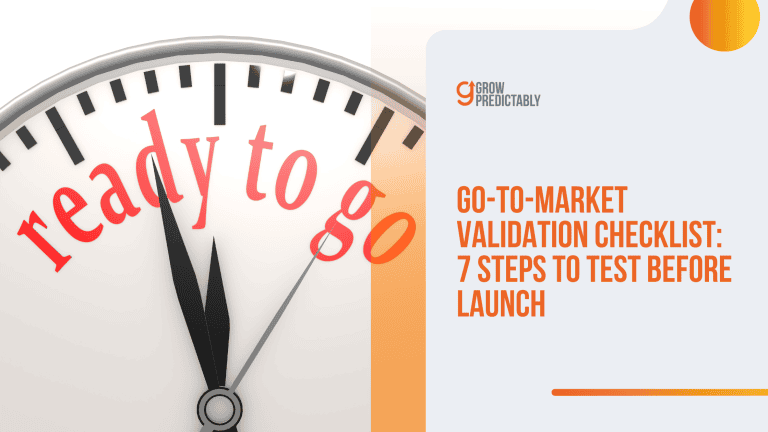How to Craft the Ultimate SaaS Marketing Team Structure
Ever felt like you’re going around in circles with your SaaS marketing team setup?
You heap on effort, time, and maybe even a sprinkle of hope, only to end up pretty much where you started.
It’s not just you.
And here’s a kicker: it’s not always about the setup of your marketing operations.
There’s a whole bunch of myths floating around about SaaS marketing teams.
One popular myth?
The old ‘set-and-forget’ approach.
Yep, some folks think it’s a one-time deal.
Spoiler alert: it’s not.
So, what’s this chat about?
We’re here to bust those myths open and get down to the nitty-gritty of what makes a B2B SaaS marketing team click.
Spoiler alert number two: it’s all about a well-crafted team design.
Get this right, and you’ll see a difference in how your team interacts with potential and existing customers.
I’ll walk you through dodging these roadblocks and steering towards a B2B SaaS marketing team that’s not just effective but killer at what they do.
Ready to break free from the cycle and get your team on the path to real results?
Let’s get this show on the road!
What Do SaaS Marketing Teams Do?
In the simplest terms, SaaS marketing teams are the wizards behind the curtain, making sure that the right people learn about your product in a way that feels both inviting and irresistible.
Here’s what you need to know about their magic:
- They Craft Tailored Messages: These teams get elbow-deep in customer data to understand what your audience really wants, turning those insights into killer marketing campaigns.
- Focus on Retention as Much as Acquisition: It’s not just about getting new sign-ups; keeping them happy and engaged is just as crucial. These teams create educational content, onboarding emails, and more to keep customers around for the long haul.
- Leverage the Latest Tech: Whether it’s SEO tools, marketing automation, or data analytics, SaaS marketing teams, typically supervised by marketing operations managers, use the latest technology to stay ahead of the curve.
How Can You Benefit From a B2B SaaS Marketing Team?
Now for the big question: why should you care? Here’s why securing a top-notch B2B SaaS marketing team can be a game-changer for your marketing efforts:
- Higher Conversion Rates: With a targeted approach, these teams ensure you’re speaking directly to the needs and pains of your audience, boosting those all-important conversion rates.
- Cost-Effective Strategies: By focusing on the right channels and marketing strategy, your marketing spend becomes an investment, not an expense.
- Staying Ahead of Trends: The SaaS world moves fast, but so do these teams. They’ll keep your marketing strategies fresh and competitive, so you never fall behind.
Here’s a stat that’ll knock your socks off: According to a report by Blissfully, SaaS spending per company is growing more than 50% year over year.
This growth isn’t just about buying SaaS; it’s about strategically selling it, and the marketing department is at the heart of this process.
Understanding Core SaaS Marketing Roles

Now that we’ve covered the what and why, let’s take a look at the tactics that the most efficient SaaS marketing teams exercise to limelight your SaaS product in the digital market.
Growth Marketing – The Engine of User Acquisition
Think of growth marketing as the powerhouse driving users towards using your service.
Your growth marketer?
They’re the frontman.
These people are on the front lines of your marketing operations, grabbing attention and pulling people in.
What they do is kind of an art and a science mixed together.
These pros aren’t just throwing stuff at the wall to see what sticks.
Instead, they’re:
- Experimenting across different channels to find what resonates with your audience.
- Analyzing data to see what’s working (and what’s not), then doubling down on the sweet spots.
- Harnessing the power of A/B testing to constantly improve conversion rates.
Their marketing efforts focus on user acquisition.
From social media to SEO, they play the tunes that get people to your front door.
A killer example?
Dropbox’s referral program supercharged its user base from 100k to 4M in just 15 months.
That’s the kind of exponential growth that gets you in the SaaS hall of fame!
Product Marketing – Connecting Products with Customers
Here’s where it gets real interesting—product marketing.
Product marketing bridges what you offer and the people who need it.
But it’s not just about listing features.
Product marketing is about telling your story in a way that resonates with your customer’s very soul.
Product marketers are your storytellers.
They know your product inside and out, and more importantly, they know how to explain it to your customers in a way that makes them think, “Wow, I need this. Yesterday.”
In product marketing, they focus on:
- Crafting messaging that highlights your product’s unique features and benefits.
- Developing go-to-market strategies that ensure a smooth product launch.
- Creating resources like sales enablement tools and product guides to help your sales team shine.
Their role is all about making sure customers not only understand but also love what you’re sales team is offering.
When Salesforce launched back in 1999, it claimed just 1% of the CRM market.
Fast forward to today?
It’s the crème de la crème, thanks to stellar product marketing, that made people realize the value of switching to the cloud.
Content Marketing – Building Relationships with Potential and Existing Customers
Content marketing is the bridge that keeps potential customers engaged while they’re not yet ready to buy.
It’s also a way to nurture existing customer relationships and keep them coming back for more.
Your content marketer knows how to create entertaining, educational, or engaging content that aligns with your brand voice and resonates with your audience.
They’re in charge of:
- Creating a content strategy that includes various types of content (blog posts, videos, social media, etc.) to reach different segments of your audience.
- Developing a content calendar and managing deadlines for publication.
- Tracking metrics and analyzing data to see what’s resonating with your audience and adjusting the content strategy accordingly.
A prime example of killer content marketing is HubSpot’s blog.
They consistently produce high-quality, helpful content that attracts and retains customers.
In fact, their blog generates over 100k leads per month!
Brand Marketing – Building a Trusted Brand Identity
Brand marketing is where the magic of storytelling meets the science of consumer trust.
Building a brand isn’t a sprint; it’s more like a marathon… with hurdles… and sometimes fire-breathing dragons.
Brand marketers are setting the stage—making sure there’s instant recognition when someone sees your logo or hears your name.
It’s not just about looking good (though that’s a part of it). It’s about building a rep.
When people trust you, they’re more willing to take a leap with you.
Brand marketers work on the following:
- Crafting stories that engage and resonate with your target audience.
- Establishing a consistent, memorable brand voice and aesthetic across all platforms.
- Engaging with customers and the wider community to build a loyal following.
Their endgame?
Turn your SaaS company into a brand that stands out in the crowded marketplace.
A great example of brand marketing done right is Slack’s workplace revolution narrative, which has transformed “just another messaging app” into a synonym for workplace innovation.
Optimizing Your SaaS Marketing Team’s Structure
So, you’re trying to get the most out of your marketing operations and, most especially, your B2B SaaS marketing team?
Figuring out the best team structure might just be the key.
Let’s explore some common setups, their upsides and downsides, and how you can track what works best over time with the Growth Scorecard.
Understanding Different Team Structures
Alright, you’re looking for the inside scoop on SaaS marketing teams, and I’ve got the goods.
Let’s break down the most common structures so you can make the best call for your team.
Centralized Structure
Picture a pyramid with your marketing maestro at the top calling the shots. That’s a centralized structure for you.
It keeps everyone rowing in the same direction with a unified marketing strategy.
Pros:
- Simplicity. You won’t be juggling a dozen different strategies.
- Consistency is king. One voice, one brand.
- Decisions can be made quickly at the top, which keeps things moving.
Cons:
- It can get rigid. New ideas have to fight their way up the pyramid.
- Sometimes, it’s clunky with adapting. Markets can change fast, and this structure might not always keep up.
Decentralized Structure
Now, flip that pyramid and spread it out.
In a decentralized setup, you’ve got multiple marketing mini-teams, each doing their own thing.
Pros:
- Flexibility is through the roof. Local teams can react in a heartbeat to what’s happening in their market.
- It’s the breeding ground for innovation. Teams can test crazy ideas without putting the whole brand at risk.
Cons:
- You might find your teams are stepping on each other’s toes without a tight plan.
- Keeping the brand voice consistent can be like herding cats. Tough, but not impossible.
Hybrid Structure
Think of a hybrid as the best of both worlds.
You’ve got a central hub with clear directives, but satellite teams tailor those marketing strategies to their locale.
Pros:
- Balanced. You’ve got consistency and flexibility sitting in a tree, K-I-S-S-I-N-G.
- It’s scalable. As you grow, this structure grows with you, no sweat.
Cons:
- It’s a balancing act. Get it wrong, and you could have a tug-of-war between teams.
- You’ll need ace managers who can navigate both worlds.
Now, let’s not just spitball here.
According to Forbes, companies that adapt their marketing strategies to their operational realities can see a whopping increase in effectiveness.
Using the Growth Scorecard
Okay, choosing a structure is one thing, but how do you know it’s really working?
That’s where the Growth Scorecard steps in. It’s not just about keeping score; it helps you see the bigger picture by linking your team’s activities directly to business outcomes.
By setting clear KPIs and measuring them regularly, you can spot what’s working and what’s not.
This means you can tweak your team structure based on real data, not just gut feel.
Scalable Team Structures for SaaS Companies of All Sizes
Alright, so how do you make sure your B2B SaaS marketing team can grow with you?
From a scrappy startup to a thriving enterprise, the key here is flexibility and scaling smart.
Look, I’ve been in the weeds with this.
I’ve seen teams buckle under pressure because they couldn’t ramp up their marketing efforts when things took off.
Here’s what I learned:
- When you’re small, stay lean, but hire versatile marketers who can wear multiple hats. As you grow, start specializing in roles but maintain that collaborative spirit.
- Implement systems that can scale with you. Think project management tools and platforms that support collaboration – they’ll become your best friends.
- Never underestimate the power of communication. As you grow, keeping everyone aligned on goals and strategies is what keeps the machine running smoothly.
Adapting Structures Based on Company Growth Phases
Remember, what works now might not cut it tomorrow.
Here’s how you can adapt:
- Startup Phase: Go lean. Fewer people, more hats to wear. Your focus? Speed and agility.
- Growth Phase: Start adding specialists to the mix. You need people to dig into data, content, SEO, and user experience.
- Expansion Phase: Time to bring in the big guns – managers and directors who can steer departments while maintaining the vision.
Remember, no matter where you are, keep that growth scorecard handy.
It’s not just about growing your team; it’s about growing it the right ball game.
7 Advanced Strategies for Enhancing Your SaaS Team Efficiency

Boosting your team’s efficiency isn’t rocket science, but it does require some savvy moves.
Let’s break down five strategies to help your team run like a well-oiled machine.
1. Implement Agile Marketing Methodologies
Here’s the scoop: agile marketing is about flexibility, velocity, and, that’s right, teamwork.
It’s like jazz, where everyone riffs off the same sheet but improvises to keep things fresh and engaging.
For you, it means running circles around your competitors because you can adapt to new info and pivot strategies at the drop of a hat.
Efficiency skyrockets because your team is focused, actions are prioritized, and wasted time goes out the window.
If you’re not Agile yet, your marketing efforts are basically like running a race with your shoes tied together.
- Break projects into phases with clear goals.
- Keep meetings short and actionable—no hour-long snoozefests.
- Iterate, learn, improve—it’s a cycle that keeps you ahead.
2. Utilize Marketing Automation Tools
Imagine having an assistant who works 24/7, never needs a break, and handles the repetitive stuff.
That’s automation for ya.
With it, your team can manage marketing campaigns, emails, and social media marketing like they’ve got superpowers, freeing up time to strategize and create—ya know, the meaty stuff.
Automating the mundane means your team’s time is spent where it truly counts: on initiatives that drive growth and keep your clients coming back for more.
- Auto-schedule social media posts when your audience is online for social media marketing.
- Set up trigger-based emails for real-time customer engagement.
- Use analytics to continually refine automation for peak performance.
3. Focus on Data-Driven Decision Making
Here’s the deal: data has the answers if you ask the right questions.
Data-driven decision-making eliminates guesswork; it’s like turning on the headlights while speeding down the information highway.
You get to know your customers inside out—what they love and what they scroll past—knowledge that pumps up your team’s efficiency and tailors your strategies for better results.
- Run regular reports to keep track of your KPIs.
- Use A/B testing to fine-tune emails, landing pages, and ads.
- Apply customer feedback to make sure your product is a perfect fit.
4. Enhance Team Skills with Continuous Learning
Here’s the lowdown: The SaaS industry moves faster than a cheetah on a sugar rush.
Continuous learning is your ticket to keep up.
Encouraging your team to learn and grow means they’re always ready to handle new challenges with the latest knowledge.
You become an efficiency powerhouse because everyone’s skill sets are evolving, keeping your strategies sharp and your solutions innovative.
- Reimburse courses or workshops relevant to their expertise.
- Create a library of resources for on-demand knowledge snacking.
- Encourage knowledge-sharing sessions to learn from each other’s experiences.
5. Streamline Communication and Collaboration
Ever played the game Telephone?
By the time the message gets back to you, it’s a hot mess.
That’s why streamlined communication is key to SaaS efficiency.
When your team has clarity, they spend less time deciphering mixed messages and more time executing killer strategies.
Collaboration tools give everyone a real-time update so that you’re all sprinting in the same direction—towards success.
- Adopt project management software to keep track of who’s doing what.
- Create communication norms, like when to email vs. instant messages.
- Schedule regular catch-ups to ensure no one’s left in the dark.
6. Optimize Content Marketing Strategies
What’s the word on the street about content?
It’s gotta be the right street, and the word’s gotta be loud and clear.
By optimizing your content marketing, you’re ensuring that you’re not just throwing words into the void but actually reaching and engaging your audience.
This also involves brand marketing to keep things consistent and loyal to the branding, regardless of the changes you make for optimization.
This boosts your team’s efficiency because every piece in your content marketing strategy is targeted, intentional, and more likely to convert.
- Leverage SEO tools to make sure your content gets seen.
- Tailor your content for different stages of the customer journey.
- Measure content performance and tweak for better results.
7. Regularly Review and Optimize Marketing Processes
Last, but no way least, stay on your toes by regularly giving your processes a health check.
What’s going well?
Great, do more of that.
Stumbling blocks?
Fix ’em, and fast.
Efficiency is all about refining and perfecting your methods to ensure you’re always at the top of your game.
- Host quarterly reviews to assess the effectiveness of your strategies.
- Get the team to share their wins and opportunities for improvement.
- Stay adaptable because, in SaaS, the only constant is change.
Common Mistakes When Building Your SaaS Team

Building a strong B2B SaaS marketing team is crucial.
After all, these are the folks who’ll help your service stand out in a sea of competitors. But hey, even the best of us can trip up.
Here’s where others have stumbled—so you don’t have to:
- Not Establishing Clear Roles: Imagine a soccer team where everyone decides to be the goalie. Sounds chaotic, right? That’s what happens when roles in your SaaS marketing team aren’t clear.
- Hiring for Skills Alone: Skills on paper are shiny, but if the person can’t vibe with your team’s culture, it’s a no-go. Remember, skills can be taught, but attitude is not so much.
- Overlooking Data: Here’s a hard fact – data-driven companies are up to 67% more efficient than their competitor. If your marketing strategy isn’t backed by data, you’re likely missing out on major growth opportunities.
- Ignoring the Customer Journey: Every customer takes a unique path to find you. If your team doesn’t understand or utilize this journey, your marketing might miss its mark.
- Skipping on Training: The digital world evolves at breakneck speed. A team that doesn’t grow its skillset will quickly fall behind, no matter how skilled they were at the start.
Key Takeaways
Whew, that was a lot of info to take in.
We get it—boosting your SaaS team’s efficiency might seem like a big mountain to climb, but with these advanced strategies in your toolkit, you’re well on your way to smoother marketing operations and bigger wins.
Remember, it’s not about changing everything overnight with your marketing department. Start with small, manageable steps and build from there.
Each tweak and improvement propels your team closer to peak performance.
So, keep these tips in mind, stay adaptable, and watch your team’s efficiency soar.
Happy SaaS-ing!








